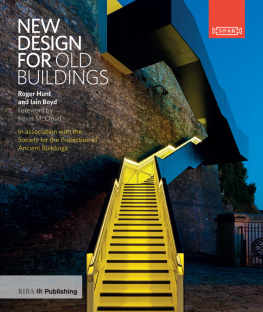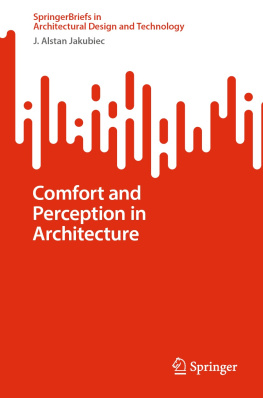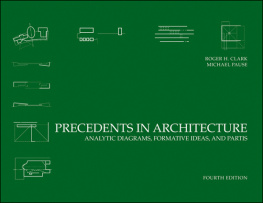Roger Hunt - New Design for Old Buildings
Here you can read online Roger Hunt - New Design for Old Buildings full text of the book (entire story) in english for free. Download pdf and epub, get meaning, cover and reviews about this ebook. year: 2019, publisher: RIBA Publishing, genre: Romance novel. Description of the work, (preface) as well as reviews are available. Best literature library LitArk.com created for fans of good reading and offers a wide selection of genres:
Romance novel
Science fiction
Adventure
Detective
Science
History
Home and family
Prose
Art
Politics
Computer
Non-fiction
Religion
Business
Children
Humor
Choose a favorite category and find really read worthwhile books. Enjoy immersion in the world of imagination, feel the emotions of the characters or learn something new for yourself, make an fascinating discovery.
- Book:New Design for Old Buildings
- Author:
- Publisher:RIBA Publishing
- Genre:
- Year:2019
- Rating:5 / 5
- Favourites:Add to favourites
- Your mark:
- 100
- 1
- 2
- 3
- 4
- 5
New Design for Old Buildings: summary, description and annotation
We offer to read an annotation, description, summary or preface (depends on what the author of the book "New Design for Old Buildings" wrote himself). If you haven't found the necessary information about the book — write in the comments, we will try to find it.
Roger Hunt: author's other books
Who wrote New Design for Old Buildings? Find out the surname, the name of the author of the book and a list of all author's works by series.
New Design for Old Buildings — read online for free the complete book (whole text) full work
Below is the text of the book, divided by pages. System saving the place of the last page read, allows you to conveniently read the book "New Design for Old Buildings" online for free, without having to search again every time where you left off. Put a bookmark, and you can go to the page where you finished reading at any time.
Font size:
Interval:
Bookmark:

RIBA Publishing, 2017
Published by RIBA Publishing, part of RIBA Enterprises Ltd, The Old Post Office, St Nicholas Street, Newcastle upon Tyne, NE1 1RH
ISBN 9781859466124
The rights of Roger Hunt and Iain Boyd to be identified as the Authors of this Work have been asserted in accordance with the Copyright, Designs and Patents Act 1988 sections 77 and 78.
All rights reserved. No part of this publication may be reproduced, stored in a retrieval system, or transmitted, in any form or by any means, electronic, mechanical, photocopying, recording or otherwise, without prior permission of the copyright owner.
British Library CataloguinginPublication Data
A catalogue record for this book is available from the British Library.
Commissioning Editor: Elizabeth Webster
Design and production: Michle Woodger
Printed and bound by WG Baird, Great Britain
Cover design: Kneath Associates
Cover image/Image credits: Royal William Yard, Plymouth Gillespie Yunnie Architects / Urban Splash
While every effort has been made to check the accuracy and quality of the information given in this publication, neither the Authors nor the Publisher accept any responsibility for the subsequent use of this information, for any errors or omissions that it may contain, or for any misunderstandings arising from it.
The Society for the Protection of Ancient Buildings (SPAB) is a charitable company limited by guarantee registered in England and Wales. Company number 5743962. Charity number 1113753. Scottish charity number SCO39244.
by Kevin McCloud

This book skilfully deals with one of the horny nubs of architecture: how to work on and with old buildings in such a way that respects and reveres them, while also adding of our time, while also aiming for something yet greater a dialogue between ancient and modern that lifts the value and meaning of both. In this it embodies the core values of the man whose writings were highly influential in the foundation of the conservation movement in nineteenth century Britain, John Ruskin, who wrote: Our duty is to preserve what the past has had to say for itself, and to say for ourselves what shall be true for the future.
Its an important point, wellmade in this volume and worth repeating nay, shouting from the shingle and sedum rooftops that good conservation demands a clear and rigorous contemporary approach for new work just as much as it requires delicacy and respect in dealing with the past. We muddle the two at our peril because it leads to rootless, confusing and ineffectual architecture that does not speak of its time or value its own past.
Doing both these things well and clearly, however, is a mark of a civilised culture and we have come to recognise that those cities in which the historical fabric is conserved and celebrated alongside confident, contemporary architecture are places that score most highly for liveability. Making sense of the past, after all, helps us understand where we are and where were going.
But physically joining up old and new is something else. If standalone new architecture is a complicated business, the process of designing new buildings to adapt and reinvent ancient ones is a fraught one. Roger and Iain bring a discerning critical eye to this finickity corner of architecture, one beset by the challenges and conditions of both contemporary building requirements and the onerous demands of dealing with protected, fragile and sometimes poorly built dangerous structures. In this book they skilfully guide us through the work of some of the best 21st century examples, their erudition underscored by a deep understanding of conservation theory and principles.
Importantly, they also bring an understanding of something less tangible. How, by reworking, refreshing and reimagining our built environment, we revitalise its stories and therefore ourselves. We are narrative creatures who make sense of our world in our imaginations, assembling our own story from that of what is around us. This book shows how we can make that narrative clear, true and vital while adding to it with the energy and truth of our own time.
Kevin McCloud
Please note that every building is different, and so designs, materials and suggestions examined in this book will not be relevant in every instance and should not be applied without careful thought. If you are in doubt, seek suitably experienced professional advice. This also relates to the photographs and illustrations, which may indicate an approach but should not be treated as a guarantee of a suitable course of action in every circumstance.
The UK has strict laws which protect historic buildings, areas, sites and landscapes, and it is in your interest to adhere to these. Before beginning any work of repair, alteration or development to a building, any structures within its grounds or the site on which it stands, it is essential to check with the local planning authority whether any consent will be needed. In the case of all listed buildings, remember that the interior as well as the exterior is protected and that the listing may extend to ancillary structures within the curtilage of the main building.
New design for old buildings must be seen as just one phase in a long timeline spanning decades, even centuries., and succeeds when the relationship between new and old is well understood and skilfully managed. Good new design requires a deep understanding of what has gone before, as well as a vision of how the new and old parts will perform together long into the future. In this book, we have followed the SPAB principle that good new architecture can sit happily alongside old and is preferable to poor pastiche; our aim is to provide an insight into the factors and considerations that go towards making a successful scheme.
Many examples of new design in old buildings have been chronicled and celebrated in recent years, often featuring projects from North America and Europe. In this book, we focus solely on buildings from within the UK, and our research has revealed a rich supply of exemplary schemes, both large and small, as well as countless designers and craftspeople who demonstrate a thoughtful and creative approach. By its nature, it is not an exhaustive study, and there are many good projects which space has precluded us from mentioning.
Buildings result from collaborative effort and a creative vision shared between a number of people. Much of our focus is on the architects and designers who provide the vital narrative of imaginative thinking and execution. Architects understand that design is an overarching process that provides both a solution to an entire building brief and deals with more specific smallscale issues of detailing. We do not presume to set out in depth the processes of design nor the specifics of what design is.
We have attempted to present the best philosophical and practical thinking on the subject. The old buildings featured in this book date from the medieval period to the second half of the twentieth century, where the same issues and problems are found. Rather than analysing a select few case studies, we have drawn from a larger sample and looked at more than one hundred buildings; some appearing once within the book, others numerous times. In some cases the element of new work we have chosen may stand out as exemplary over other lessinformed work within the same scheme. A selection of featured buildings follows this preface.
Font size:
Interval:
Bookmark:
Similar books «New Design for Old Buildings»
Look at similar books to New Design for Old Buildings. We have selected literature similar in name and meaning in the hope of providing readers with more options to find new, interesting, not yet read works.
Discussion, reviews of the book New Design for Old Buildings and just readers' own opinions. Leave your comments, write what you think about the work, its meaning or the main characters. Specify what exactly you liked and what you didn't like, and why you think so.










